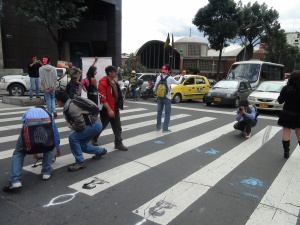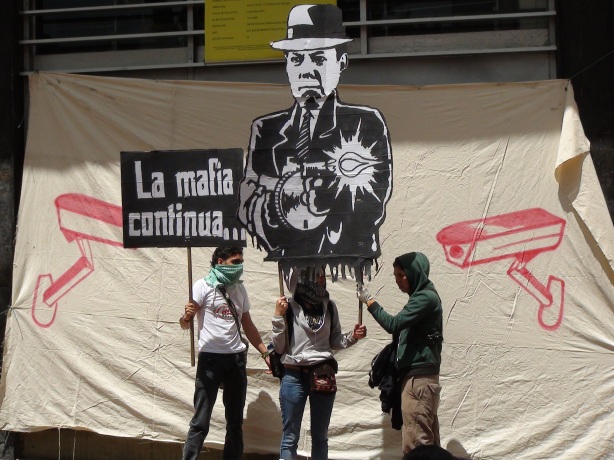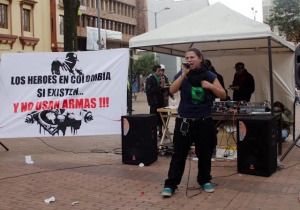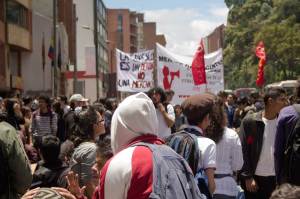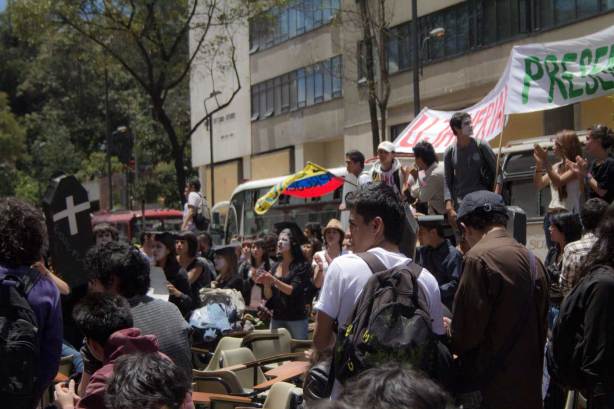Today I got a little sidetracked from my project in t he sense that it wasn’t necessarily linked to my project at Antena Mutante. In no case was it useless though as I spent the day with my newly made friends Camilo Cantor, from Cartografías Sonoras and Andres Melendez at the “Feria del Libro” (Bookfair).
he sense that it wasn’t necessarily linked to my project at Antena Mutante. In no case was it useless though as I spent the day with my newly made friends Camilo Cantor, from Cartografías Sonoras and Andres Melendez at the “Feria del Libro” (Bookfair).
I knew that especially Camilo was up to something, though I wasn’t quite sure what it was yet; something with tiles and hacking the Bogota book fair, but the how or what remained in the dark. So driven by curiosity, I met both Camilo and Andres at 3 o’clock this afternoon in Andres’ living room. As soon as I arrived I was put to work and unexpectedly, I spend my whole afternoon Photoshopping a QR code (picture). Now for those who wonder what that is, the term only became clear to me as well while doing my ‘homework’. Apparently, for the less media savvy under us, there exists a technique to transform all text into a matrix bar code, called Quick Response code (QR) and which can be generated through the Kaywa Reader website amongst others. Once you take a picture of this code with your smart phone (or a special barcode reader), it will automatically convert the code into text, for example a PDF file. And that was exactly what it was, a PDF file of “Free Culture” by Lawrence Lessig, as well as “Free Software, Free Society” by Richard Stallman. Shortly said, both authors criticize the new way of making law which is often influenced by the large corporations that care more about their profits than about the free exchange of ideas.
Now why choose the bookfair as there are already so many books available? That was exactly it, all the books “available” were for sale and in that respect they were not really available to many people. That afternoon, Camilo told me many of the college kids were forced to visit the bookfair as a school trip, all nice, but probably none of them would have the money to actually buy a book. It was all about copyright and therefore the Book fair was the perfect place to do a small intervention such as this one. Camilo wanted to promote the idea of shared and free culture and as a real Dutch, I was thrilled by the idea of ‘free’.
From 3 o’clock in the afternoon until 7 o’clock in the evening we spent time designing, printing, cutting and sticking paper on tile, then tile on wall in order to complete our mission. Once we entered the fair, we’d have to make sure there were no cameras or security people watching us, as we would probably be kicked out of the fair immediately again. But all went smooth and we managed to stick four tiles on the walls of the toilet, near a waiting bench and on some random pass through walls until we were out of the glue of which we were dependent for our action.
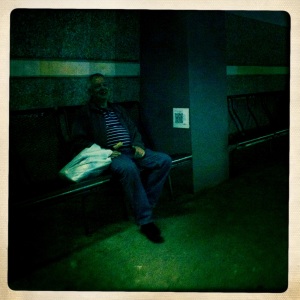 But how effective is such an action really? I couldn’t find concrete numbers of Smartphone users in Bogota, but considering that in the whole month that I was here I saw only a handful of people actually using a Smartphone, I figured it couldn’t be that many. The problem according to Camilo was rather that people that do have a Smartphone in Colombia often do not know how to use it. They still use it to call, text and surf the Internet, but do not know how to profit from it to the fullest. So the aim of the interaction was, apart from the fact that people could download the books for free, to maybe create some awareness as well about the possibilities of smartphones. And just in case, we added the link to download the book as well. Another thing that might be interesting is to automatically generate some sort of tagcloud from all the people that would actually use the QR code in order to retrieve the book, or create a platform where people can leave messages, so you can see the effect of your action. but I guess that will remain a challenge for the next intervention.
But how effective is such an action really? I couldn’t find concrete numbers of Smartphone users in Bogota, but considering that in the whole month that I was here I saw only a handful of people actually using a Smartphone, I figured it couldn’t be that many. The problem according to Camilo was rather that people that do have a Smartphone in Colombia often do not know how to use it. They still use it to call, text and surf the Internet, but do not know how to profit from it to the fullest. So the aim of the interaction was, apart from the fact that people could download the books for free, to maybe create some awareness as well about the possibilities of smartphones. And just in case, we added the link to download the book as well. Another thing that might be interesting is to automatically generate some sort of tagcloud from all the people that would actually use the QR code in order to retrieve the book, or create a platform where people can leave messages, so you can see the effect of your action. but I guess that will remain a challenge for the next intervention.
Amsterdam, interested?
